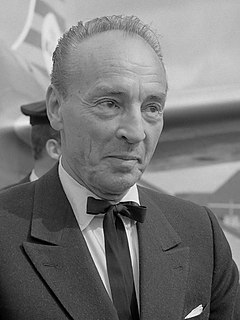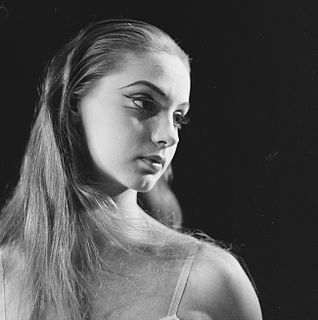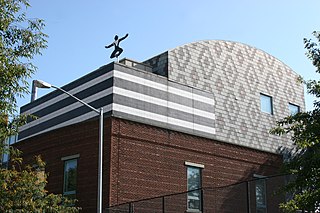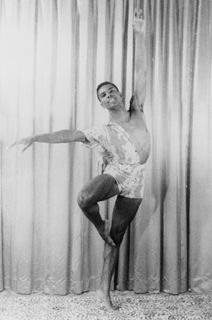
Martin Luther King Jr. was an American Christian minister and activist who became the most visible spokesperson and leader in the civil rights movement from 1955 until his assassination in 1968. King is best known for advancing civil rights through nonviolence and civil disobedience, inspired by his Christian beliefs and the nonviolent activism of Mahatma Gandhi.

George Balanchine was an American ballet choreographer who was one of the most influential 20th-century choreographers. Styled as the father of American ballet, he co-founded the New York City Ballet and remained its Artistic Director for more than 35 years.

New York City Ballet (NYCB) is a ballet company founded in 1948 by choreographer George Balanchine and Lincoln Kirstein. Balanchine and Jerome Robbins are considered the founding choreographers of the company. Léon Barzin was the company's first music director. City Ballet grew out of earlier troupes: the Producing Company of the School of American Ballet, 1934; the American Ballet, 1935, and Ballet Caravan, 1936, which merged into American Ballet Caravan, 1941; and directly from the Ballet Society, 1946.

Alberta Christine Williams King was Martin Luther King, Jr.'s mother and the wife of Martin Luther King, Sr. She played a significant role in the affairs of the Ebenezer Baptist Church. She was shot and killed in the church by Marcus Wayne Chenault, a 23-year-old Black Hebrew Israelite, six years after the assassination of Martin Luther King, Jr.

Suzanne Farrell is an American ballerina and the founder of the Suzanne Farrell Ballet at the Kennedy Center in Washington, D.C.
The School of American Ballet (SAB) is an American classical ballet school and is the associate school of the New York City Ballet, a ballet company based at the Lincoln Center for the Performing Arts in New York City. The school trains students from the age of six, with professional vocational ballet training for students aged 11–18. Graduates of the school achieve employment with leading ballet companies worldwide, and in the United States with New York City Ballet, American Ballet Theatre, Boston Ballet, San Francisco Ballet, Miami City Ballet, Pacific Northwest Ballet and Houston Ballet.

Dance Theatre of Harlem (DTH) is an American professional ballet company and school based in Harlem, New York City. It was founded in 1969 under the co-directorship of Arthur Mitchell and Karel Shook. Milton Rosenstock served as the company's music director from 1981 to 1992. The DTH is renowned for being both "the first Black classical ballet company", and "the first major ballet company to prioritize Black dancers".

Arthur Mitchell was an American ballet dancer, choreographer, and founder and director of ballet companies. In 1955, he was the first African-American dancer with the New York City Ballet, where he was promoted to principal dancer the following year and danced in major roles until 1966. He then founded ballet companies in Spoleto, Washington, D.C., and Brazil. In 1969, he founded a training school and the first African-American classical ballet company, Dance Theatre of Harlem. Among other awards, Mitchell was recognized as a MacArthur Fellow, inducted into the National Museum of Dance's Mr. & Mrs. Cornelius Vanderbilt Whitney Hall of Fame, and received the United States National Medal of Arts and a Fletcher Foundation fellowship.

The company Ballets Russes de Monte-Carlo was formed in 1932 after the death of Sergei Diaghilev and the demise of Ballets Russes. Its director was Wassily de Basil, and its artistic director was René Blum. They fell out in 1936 and the company split. The part which de Basil retained went through two name changes before becoming the Original Ballet Russe. Blum founded Les Ballets de Monte Carlo, which changed its name to Ballet Russe de Monte-Carlo when Léonide Massine became artistic director in 1938. It operated under this name until it disbanded some 20 years later.
Le Bourgeois Gentilhomme refers to two different ballets by George Balanchine set to Richard Strauss's Concert Suite (1917), with a libretto after Molière's 17th-century comédie-ballet of the same name.
Serenade is a ballet by George Balanchine to Tchaikovsky's 1880 Serenade for Strings in C, Op. 48. Students of the School of American Ballet gave the first performance on Sunday, 10 June 1934 on the Felix M. Warburg estate in White Plains, N.Y., where Mozartiana had been danced the previous day. This was the first ballet that Balanchine choreographed in America. It was then presented by the Producing Company of the School of American Ballet on 6 December at the Avery Memorial Theatre of the Wadsworth Atheneum with sets by the painter William Littlefield. Balanchine presented the ballet as his response to the generous sponsorships he received during his immigration to America. The official premiere took place on 1 March 1935 with the American Ballet at the Adelphi Theatre, New York, conducted by Sandor Harmati.
Tschaikovsky Piano Concerto No. 2, originally called Ballet Imperial, is a ballet in three movements made by New York City Ballet's co-founder and founding choreographer George Balanchine for his earlier company, American Ballet Caravan, to the version of Peter Ilyitch Tchaikovsky's Piano Concerto No. 2, originally composed in 1879–80, but later revised by Alexander Siloti. The ballet was given a preview performance on 29 May 1941 at the Little Theater of Hunter College in New York City. The premiere took place on 25 June 1941 at Teatro Municipal, Rio de Janeiro.
Mozartiana is a ballet by New York City Ballet co-founder and balletmaster George Balanchine which opened their Tschaikovsky Festival. It is the choreographer's third homage to Mozart and is set to Pyotr Ilyich Tchaikovsky's Suite No. 4, Mozartiana, Op. 61 (1887), consisting of:
Vienna Waltzes is a ballet made by New York City Ballet co-founder and founding choreographer George Balanchine to music by Johann Strauss, Jr., Franz Lehár, and Richard Strauss:
Liebeslieder Walzer is a ballet by New York City Ballet co-founder and ballet master George Balanchine, based on the Brahms' Liebeslieder Walzer, Op. 52, and their sequel Neue Liebeslieder, Op. 65.

The sermons and speeches of Martin Luther King Jr., comprise an extensive catalog of American writing and oratory – some of which are internationally well-known, while others remain unheralded, and some await re-discovery.
Ivesiana is a ballet made by New York City Ballet co-founder and ballet master George Balanchine to Charles Ives' Central Park in the Dark (1906), The Unanswered Question (1906), In the Inn (1904-06?), and In the Night (1906) shortly after the composer's death. The premiere took place September 14, 1954, at the City Center of Music and Drama. Other works to the music of Ives in the City Ballet repertory include Peter Martins' Calcium Light Night, Jerome Robbins' Ives, Songs and Eliot Feld's The Unanswered Question.

James Earl Ray was an American fugitive and felon convicted of assassinating Martin Luther King Jr. at the Lorraine Motel in Memphis, Tennessee, on April 4, 1968. Ray was convicted in 1969 after entering a guilty plea—thus forgoing a jury trial and the possibility of a death sentence—and was sentenced to 99 years' imprisonment. At the time of his death, he had served 29 years of his sentence.

Martin Luther King Jr., an American clergyman and civil rights leader, was fatally shot at the Lorraine Motel in Memphis, Tennessee on April 4, 1968 at 6:01 p.m. CST. He was rushed to St. Joseph's Hospital, where he died at 7:05 p.m. He was a prominent leader of the civil rights movement and a Nobel Peace Prize laureate who was known for his use of nonviolence and civil disobedience.

Concerto Barocco is a neoclassical ballet made for students at the School of American Ballet by George Balanchine, subsequently ballet master and co-founder of New York City Ballet, to Johann Sebastian Bach's Concerto in D minor for Two Violins, BWV 1043. After an open dress rehearsal on May 29, 1941, in the Little Theatre of Hunter College, New York, the official premiere took place June 27, 1941, at Teatro Municipal in Rio de Janeiro as part of American Ballet Caravan's South American tour.











